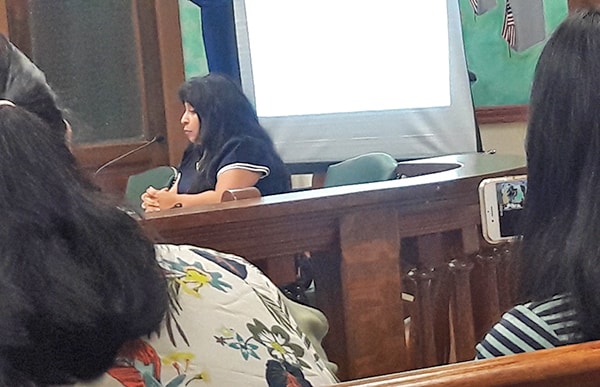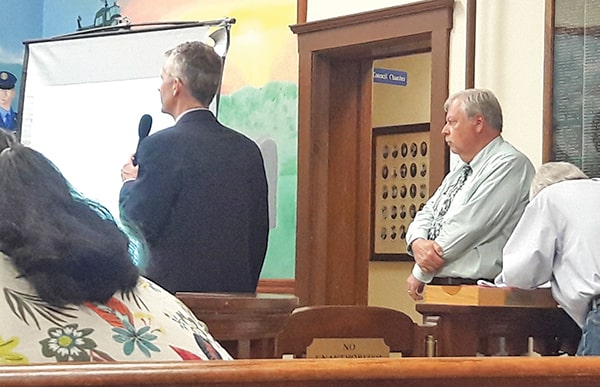
Resident Sharon Hubberman gives a presentation at the 7/10/19 Council Meeting
*Photos by Carolyn Maxwell
By: Carolyn Maxwell
 PERTH AMBOY – Three individuals were present to give a presentation on the CSO (Combined Sewer Overflow) Report. They were Luis Perez-Jimenez (Dir. of Operations of USA-PA), 2 representatives from CDM SMITH: Howard Matteson, Principal Environmental Engineer, Sr. Project Mgr., CDM SMITH, Edison, NJ and Edward Burgess, P.E., D WRE, Senior Vice President. CDM SMITH, Cincinnati, OH.
PERTH AMBOY – Three individuals were present to give a presentation on the CSO (Combined Sewer Overflow) Report. They were Luis Perez-Jimenez (Dir. of Operations of USA-PA), 2 representatives from CDM SMITH: Howard Matteson, Principal Environmental Engineer, Sr. Project Mgr., CDM SMITH, Edison, NJ and Edward Burgess, P.E., D WRE, Senior Vice President. CDM SMITH, Cincinnati, OH.
Jimenez-Perez started, “We have a CSO permit. It’s a Long-term Control Plan which the City would have to meet certain criteria. One of the criteria would be on how you are considering to handle the overflow. We have a combined sewer overflow system.”
Burgess spoke next, “The problem happens about 70-80 times a year. The Long-Term Control Plan will be implemented over a 20-year timeframe. We are trying to reduce the control of the CSO’s. The separation of lines has been done in other states. We can build treatment plants near the discharge plant, or raingardens can be used. They would capture the overflow before it goes into the sewer system. The problem with sewer separation is that you have to tear up each street. In Chicago, IL sewer systems, they built a separate regulator that winds up in a tunnel structure. It’s self-cleaning, and a very low maintenance wastewater system. We like to do green infrastructure which would capture the water in raingardens, which is very effective. The wastewater goes into both the Arthur Kill and the Raritan River (they both flow in the Raritan Bay). There are 18 locations in Perth Amboy with combined sewer overflow points. We are using a permit process, and they are approved by the NJDEP and the EPA. The Middlesex Utility and Perth Amboy each have permits. Each permit is only for 5 years, then it expires. They will see where you are at that point before they can determine if you can reapply for another 5 years. 20 years is the cap. They have to see what kind of progress and where you are at during those 5-year increments. There are 13 approaches when dealing with CSO’s. You have to capture 85% of the overflow. Perth Amboy is part of the NJCSO (New Jersey Combined Sewer Overflow) Group. There would be an evaluation of the cost performance. The higher level of control, the higher the cost. You have to recognize the expense that the residents are paying for the service that they get. We would like to use the beaches to control the CSO’s. These decisions have to be made by June 1, 2020. Sensitive areas can be relocated if possible.”
Howard Matteson then spoke. “5 groups of CSO’s are located in Perth Amboy and we selected the ones that were close to one another. The flow (of the water) goes from the top to the bottom ending at the Second Street Pump Station. Over the 20-year period, the cost (to the City) can be anywhere between to $300 million to $600 million. The City will be the regulator of the location. We would commit to the CSO Plan that the City chooses. The cost would be based on the amount of money to maintain the system and additional costs for the improvements to the system.”
After they gave their report, Resident Sharon Hubberman had her own hearing (Hearing of the Citizens) to talk about water quality concerns. She stated that she was not here to represent any company. During Hubberman’s presentation, she read information and had a PowerPoint Presentation displayed on a screen behind her to show where the information was from. She stated, “Our water comes from groundwater.” She was concerned about the dioxane (one of the contaminants – 1,4-Dioxane is a heterocyclic organic compound, classified as an ether. It is a colorless liquid with a faint sweet odor similar to that of diethyl ether. The compound is often called simply dioxane because the other dioxane isomers are rarely encountered.) in the water. Her concerns were also about the rise of contaminants in Perth Amboy’s water and how it can affect a person’s health when a certain level is reached. “The State can no longer wait for the Federal Government to clean up our water. There are violations of THM (a group of 4 chemicals that are formed along with other disinfection biproducts when chlorine or other disinfectants used to control microbial contaminants when drinking water reacts with naturally occurring organic and inorganic matter in water) and lead.” She showed a report on testing of lead in the blood in children in Perth Amboy between ages of 6 months to 26 months of age. There was a rise in the levels of lead in a 4-year period shown in the chart. “We need actions regarding lead. We need a commission authority, an environmental commission and a citizen’s action group. Workshops are needed. Contact our legislative leaders and quality control groups. We need an engineering assessment.”



